This page has been put together to help people new to the Gypsy Vanner Horse learn more about this fascinating breed. We do not claim to be experts on these subjects yet, so much of it has been gathered from fellow breeders and other sources of Gypsy information. If you find errors or think that we need to include additional material, please contact us.
The information has been organized by topic. Just click on the topic to go to the section that you are interested in.
|
|
| About Us
Big Sky Gypsy & Drum Horses is a small family farm located in the heart of the Rocky Mountains of Montana. We have raised and ridden saddle horses all of our lives. Riding in the mountains surrounding our home and outfitting in the beautiful Bob Marshall Wilderness we have come to value sound, sane, people oriented horses. We began our journey with the Gypsy Vanner Horses when we purchased our first mare Skye. She was a stunning young black Clydesdale mare with tons of hair, beautiful, white, feathered feet, and an incredible disposition. While looking for a stallion to breed her to, we discovered the Gypsy Vanners and realized that they were exactly the type horse that we wanted to become involved with. Soon after, we began our search for a breeding stallion and the rest is history…
Why The Gypsy Horse?
I am often asked "Why a Gypsy Horse?" or "What drew you to this breed?" That is an interesting question, and one that individual Gypsy owners will answer differently. However, for me, even as a young girl I knew that someday I would own draft horses.
The big drafts have always filled me with awe. Such huge powerful animals yet so gentle in soul. They have a peaceful strength. So sure of themselves and their power, yet completely careful and gentle. They do not need to use their power to command admiration, and they know it.
But the Gypsies are a bit different. For me I think it is something about them that draws me back to another time and place. They seem to have the knowledge of years gone by in their eyes. As if they know things that they desire to tell you. They are so in tune with people that they communicate on another level - different than most horses. With the Gypsies they seem to look at me and probe deeper than most horses. When folks say that they are addictive, I agree. A Gypsy horse does something to your soul I think...
Back To Topics
|
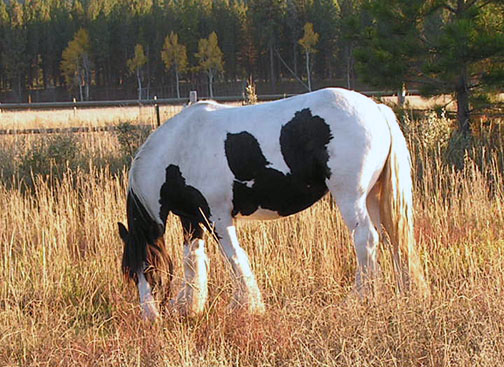
|
What Is a Gypsy Horse?
“For nearly 100 years, the Gypsies have bred and used colorful cob horses to pull their ornately decorated carts and living wagons thru the country lanes of England and Ireland. The horses they used were heavy boned and feathered horses, which were strong, sensible, docile, and incredibly hard working. The beautiful colors of these horses were not only pleasing to the eye, but also made them instantly recognizable, which helped to prevent them from being stolen or swapped discretely for inferior horses. The heavy feather on their legs, along with long flowing manes and tails added to the overall flash and flare long associated with the misunderstood and usually discriminated-against gypsy people."
"Traditionally, the Gypsy Horse is involved in every aspect of family life, faithfully pulling the caravan wagon by day, while still being patient enough to teach the gypsy children to ride when the day is done. The horses are tethered at the campsite with the family caravan when they are not working. They live and thrive in all types of weather grazing on the grasses that happen to be growing along the side of the roads. The heartiness and exceptional disposition of these horses are their trademarks. They are known for being one of the most docile and gentle horses in the world. " |
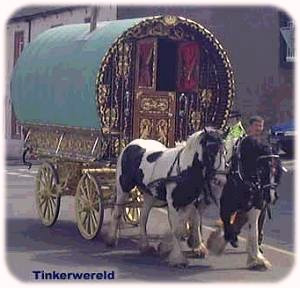 |
"Here in the U.S., the various types of gypsy horse have come to be known by several different names. Irish Tinker, Gypsy Vanner, Gypsy Cob, Irish Cob, Romany Horse and the like, are all names used to describe the type of horse which gypsies have bred and used in the British Isles for generations. Although many horses of similar type are bred indiscriminately in Europe, the most sought after type of gypsy horses are bred by generations of gypsy families, who have prized and guarded bloodlines that produce the highest quality horses imaginable. The Gypsy horse is extremely rare in North America, numbering only around 400 individuals." Back To Topics
Information Compliments of Black Forest Gypsy Horses
|
What Is a Drum Horse?
“Actually named after a “job” performed by the horse, The Drum Horse is an indispensable part of the Band of the Life Guards. These horses carried two large solid silver kettle Drums, plus a fully outfitted rider, through crowds of thousands, during the Queen’s processions! The extraordinary part was that these horses were controlled entirely by reins attached to the rider’s feet, as they had to use their hands to beat on the drums. The Cavalry Drum Horse is one of the most popular and recognizable members of the regiment. Nearly always piebald or skewbald in color, although it is also common to see solids, they stand at least 16 hands.
Drum Horses must be strong and steady enough to carry the stout kettle drums during ceremonies. It takes a very special horse to carry such a prominent role in the Queen's Household Cavalry." Information compliments of Old Mill Farms |
Today the Drum Horse is achieving breed status in the United States. A registry has been formed and the criteria for breeding Drum Horses has been established. For registry in the United States, a Drum Horse must be a cross between a Gypsy Cob and a Clydesdale, Shire, or Friesian.
Back To Topics
|
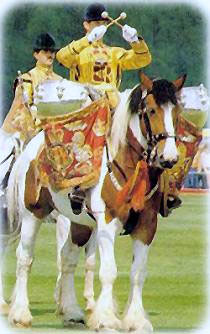 |
Color Genetics Explained
The Tobiano (Pinto) color pattern is controlled by a dominant allele (T) in the gene pair that dictates coat color pattern. A homozygous stallion has both dominant alleles for the trait (TT), therefore he always pass on the (T) for the Tobiano coat pattern to his foals. If he is bred to a mare that is Tobiano but carries the solid color gene (Tt) foals will be Tobiano. Genetically speaking, in this cross, there is a 50% chance the resulting foal will be homozygous for the Tobiano coat pattern (TT). There is also a 50% chance that the foal will be (Tt) expressing Tobiano, but carrying the solid gene inherited from the mother.
If you breed a homozygous stallion (TT) to a solid colored mare (tt) ALL the foals will will be Tobiano, but be carriers for the solid color (Tt). How the Tobiano pattern is expressed is another thing altogether. The foal may be loudly marked or barely marked at all.
So what happens if you cross a Tobiano stallion that is NOT homozygous (Tt) with a Tobiano mare that is NOT homozygous (Tt)? There is a 75% chance of getting the Tobiano coat color and a 25% chance of getting a solid color foal. Genetically, there is a 25% chance that the foal will be homozygous Tobiano (TT), a 50% chance the foal will be Tobiano but carrying the solid gene (Tt), and a 25% chance the foal will be solid color (tt).
If you cross a Tobiano stallion that is NOT homozygous (Tt) with a solid colored mare (tt) you would have a 50% chance for a Tobiano foal (Tt) and a 50% chance for a solid color foal (tt). But remember, Mother Nature doesn't always play by the rules of probability when it comes to genetics!
Back To Topics
|
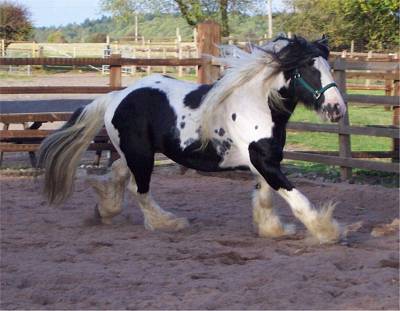
Homozygous horses often have "ink spots" or
"paw prints" in their pattern.
|
 This homozygous filly even has "ink spots" on her nose!
This homozygous filly even has "ink spots" on her nose!
|
All About Hair
One of the most obvious characteristics of the Gypsy Vanner is it's amazing hair!!! Thick full manes and tails that drag the ground are the hallmark of a quality Gypsy Vanner. In order to command the admiration of fellow Gypsy breeders an man's stock must possess and pass on the luxurious hair.
Another unique characteristic of the Gypsy Vanner is the facial hair. The horses that are really heavy in hair will also often have a beard of long hairs under the jaw, and sometimes even a moustache.
Feathering is an inherited trait passed down and enhanced through generations of careful breeding. The amount and quality of feather separates the superior Gypsy Vanner from the average one.
To qualify as a "feathered" breed a horse must have ground-length hair completely around the hoof. However, by Gypsy standards this is not adequate. A superior Gypsy Vanner will have full, thick hair that starts behind the knee or hock and continues to the ground. Often the feather will also grow down the front of the leg as well. The hair of the feather should be fine, straight, and silky not coarse and kinky. A horse that lacks this thick feathering will not be kept for breeding by the Gypsies, but will be sold.
At times the Gypsy Vanners will lose the bottom edges of their feather in a condition referred to as being "bog burned." This occurs during the wet season when the mud accumulates on the feather and the weight actually breaks the hair off. You can tell a bog burned horse from a poorly feathered one by observing the obvious line of breakage above which the hair is still full. This condition is not unusual in the UK and most horses grow their feather back in a couple of months.
A poorly feathered horse will have thin, wispy feather on the leg which will barely cover the hoof. A horse with this type of feather should be avoided at all cost!
Back To Topics
|
Good Examples of Feather....
|

Our youngest mare showing off her excellent feather |
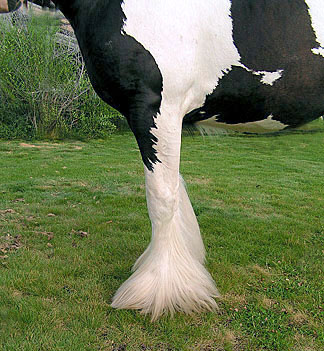
Aisling's feather is outstanding for a mare.
|
Why Breed To A Gypsy Horse?
People are often interested in a Gypsy cross-bred and we are asked, “What kind of a horse can I expect out of a Gypsy cross?” The decision to breed your mare to any particular breed is a personal choice, which requires careful consideration. In order to facilitate this process we have tried to explain the potential outcomes of certain Gypsy crosses. For this discussion we are going to assume that we are using a homozygous Gypsy stallion, so that a foal with color is guaranteed.
To begin with, the Gypsy Horse is a medium-sized draft breed. It is a versatile, highly intelligent, gentle athlete. The Gypsy Vanner Horse possesses the large bone and foot of its draft horse ancestors. It is a short-coupled horse with tremendous strength and stamina for its size. In England, it is typical for a Gypsy Horse to trot all day pulling the family’s heavy living wagon. They are also used successfully for fox hunting and jumping. The Gypsy Horse has the calm, quiet disposition of the cold-blooded horses. Their sensible nature makes them a perfect choice for trick training or as a child’s mount. They are calm and adapt easily to any discipline.
In addition to its physical attributes, the Gypsy Vanner possesses lovely color and tremendous hair. They come in a variety of pinto patterns and colors. Most typically they are black and white with brown or blue eyes. The thick, luxurious manes and tails combined with the flowing feather give the Gypsy Vanners a magical quality. The have a proud carriage that exudes confidence and power.
Already Gypsy Vanners and Gypsy crosses are making their mark in this country in driving, dressage, low jumping, and pleasure riding. Their size and work ethic enables them to be successful in any discipline. Best of all, with their extraordinary color and hair they are breathtaking at anything they do! Back to Topics
|
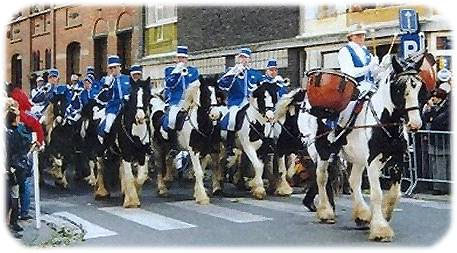
Drum Horses on Parade
Compliments of Black Forest Gypsy Horses
|
What Can I Expect When I Breed To A Homozygous Gypsy Stallion?
Gypsy X Feathered Draft
Clydesdales and Shires are known for their great size, spirit, and their animated movement. They also possess the desirable flashy coloring, full feather, and docile disposition. All of these qualities make them priceless in the big show hitches popular today. Crossing a homozygous Gypsy stallion with a Clydesdale or Shire would produce the extremely rare and valuable Drum Horse. These breathtaking horses have the size and stature of their feathered draft parent combined with the color and feathering of the Gypsy Horse. Their color, feather, and sensible disposition were qualities prized by the Queen of England when she chose these horses to carry her ceremonial drums. Today, these amazing horses are already making their presence known in the US in dressage, jumping, and driving.
Back To Topics
Gypsy X Non-feathered Drafts
Percherons and Belgians are known for their strength, large size, and calm manner. When you cross a homozygous Gypsy stallion with a non-feathered draft breed such as these, you would produce a draft horse with pinto coloring. The Gypsy / draft cross would be slightly smaller and more refined, with a thicker mane and tail, and some light feathering. And of course you would get the prized Gypsy Horse coloring. This cross would accentuate all the wonderful draft horse qualities and capture it in a slightly smaller package. Perfect for driving, parade, or pleasure.
Gypsy X Friesian
The Friesian breed is prized for its elegant stature, floating movement, and abundance of hair. When crossed with a homozygous Gypsy stallion you could expect an amazing, forward moving colored athlete. This cross would preserve all the size and self-carriage of the Friesian and wrap it in a flashy colored coat. A Friesian / Gypsy cross would have TONS of mane and tail and would also have an abundance of feather. This cross would have boundless potential, and could excel in dressage, driving, and English pleasure to name a few.
Gypsy X Warmblood
The Warmblood horses are outstanding in the jumping and dressage arena. They possess the calm nature, heavy bone, and size of their draft ancestors. They are strong and athletic, capable of the rigors of heavy jumping and competition. When crossed with a homozygous Gypsy stallion you would produce a colored sporthorse. You would be maintaining all the bone and substance and then topping it off with the eye-appealing color and flash of the Gypsy. A foal of this cross would be a show-stopping athlete.
Gypsy X Thoroughbred
The Thoroughbreds are noted for their heart and stamina, their clean, fine bone, as well as their lofty, floating gait and jumping ability. When you cross a Thoroughbred with a homozygous Gypsy stallion you will produce a colored sporthorse. The Gypsy Horse influence contributes heavier bone and thicker muscling to the lighter frame of the Thoroughbred. In addition, the Gypsy influence helps provide a calmer, more tractable disposition in a breed known to be high-strung and nervous. Foals of this cross can be expected to excel in dressage, jumping, eventing, and driving.
Gypsy X Arabian or Morgan
The Arabians and Morgans have long been popular for their fire and spirit, animated gait, and endurance. Combine this refinement and personality with the homozygous Gypsy and you would have an amazing colored athlete. The resulting foal would be a more substantial horse having more bone and muscling, but would carry itself with the proud air of its light horse parent. It would have superior stamina combined with a more tractable disposition. Plus, it would have the flashy Gypsy coloring, an abundance of mane and tail, and some light feathering. This cross would make an awesome, up-headed carriage horse that could excel in combined driving.
Gypsy X Stock Horse Breeds
Stock Horse breeds, such Quarter Horses, are valued for their intelligence, strength, agility, speed, and versatility. A Quarter Horse crossed with a homozygous Gypsy stallion would create a stocky, colored light draft horse. This animal would be smaller in stature than the larger draft breeds, but would retain much of the draft qualities such as heavier bone and muscle. This cross would be intelligent and tractable, with better stamina and a pleasant disposition. Foals of this cross would be perfect for smaller driving teams. They would be flashy enough for use in parades or a carriage business, yet solid and dependable enough for use on the farm.
|
Registry Information
Fullblood Gypsy Horses can be registered in three registries . Each registry has slightly different criteria for their horses. The Gypsy Vanner Horse Society is a registry for selectively bred fullblood stock only. The Gypsy Cob and Drum Horse Association offers registration for fullblood Gypsies and several categories for Drum Horses. The Gypsy Cob Society has categories for fullblood and crossbred Gypsy horses.
The American Drum Horse Association is a newly formed registry that is soley devoted to registering Drum Horses.
In addition to the above registries, Gypsy crosses can also often be registered in the part-blood registry of the non-Gypsy parent. For example:
Back to Topics
|
|
| |
| |
|